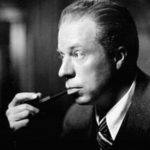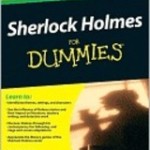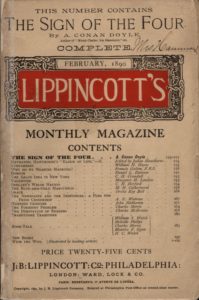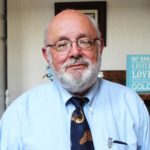A Scion Society of The Baker Street Irregulars

Data! Data! Data! – The Sign of Four
“‘Data! Data! Data!‘ he cried impatiently. ‘I can’t make bricks without clay.’”
– The Adventures of The Copper Beeches (COPP)
This column is composed of material (Data!) developed for a short course called Appreciating Sherlock Holmes that I teach twice a year in the Community Education Life Enrichment Program for a local community college. It is composed of “points of information” that are common to many / most / all of the 60 Canonical stories.
The information here has been researched by me or borrowed / stolen from many efforts of other Sherlockians.
COMMENT – This is only the second story about Sherlock Holmes. A Study in Scarlet was intended to be “one time only” so Doyle could earn a few pounds. It took an American publisher’s effort to get Doyle to use Sherlock Holmes again. Thank you Joseph Stoddard.
HERE GOES…. This month’s story is The Sign of Four
CHRISTOPHER MORLEY SAID . . .
Sherlock Holmes is roused from boredom and cocaine by Miss Morsten’s appeal. Shall she keep the blind date with the Unknown Friend? The thrilling story that follows extends to the great mutiny in India years before to a man hunt down the river Thames, a still leaves time for Dr. Watson’s quiet love story.
 DUMMIES SHORT SUMMARY (From Sherlock Holmes for Dummies by Steven Doyle & David Crowder)
DUMMIES SHORT SUMMARY (From Sherlock Holmes for Dummies by Steven Doyle & David Crowder)
“On August 30, 1889, Joseph M. Stoddard, the managing editor of the American publication Lippincott’s Monthly Magazine, held a remarkable dinner party. The guests included Oscar Wilde and Arthur Conan Doyle, two British authors whom Stoddard greatly admired and wanted to publish in his magazine. Wilde went on to contribute The Picture of Dorian Gray, and Doyle wrote The Sign of Four, the second Sherlock Holmes novel.”
PUBLISHING HISTORY
This is the second of the 60 stories published. In the U.S., it was published in Lippincott’s Magazine, Feb. 1890. In England it was published by Spencer Blackett, London, 1890. Illustrations by Richard Gutschmidt.
HOW MANY WORDS?
According to C. E. Lauderback, 1960 – – found on SHERLOCKIAN.NET website of Chris Redmond, at 43,372 words SIGN has the 57th most words (#1 is VEIL – 4,499, #56 if NAVL – 12,701)
THE BEST OF SHERLOCK HOLMES (How do Sherlockians rate this story?)
- 1927 – Arthur Conan Doyle did not have it on his list of 12 favorites
- 1959 – Baker Street Irregulars voted but did not include it on their list of 10
As with the other 3 long stories (STUD, HOUN, & VALL) it does not get ranked against the 56 short stories.
CLASSIFYING THE CASE (From the Wandering Gipsies of Grimpen Mire of Decatur, Alabama)
This case is one of 23 classified as a MURDER and one of 14 where the perpetrator was either killed, arrested, or otherwise satisfactorily handled.
CHRONOLOGICALLY SPEAKING
Doyle was often very vague about stating WHEN the tale took place and included few contemporary references to help. Whether this was done intentionally or unthinkingly, the dating of events in the Canon is a very popular pastime pursued by several of our “scholars” researching and justifying their results to no end. We will again default to William Baring-Gould’s dating of Tuesday, September 18 to Friday, September 21, 1888. This dates it as 19th of the 60 stories on the calendar as determined by Sherlockians. This means that Holmes is 34 and Watson is 36.
WHAT ELSE HAPPENED IN YEAR 1888?
It is always interesting to see what else in happening at the same time as the stories.
- Convention of Constantinople: Suez Canal declared open to ships of all nations and free from
- British East Africa Company founded.
- Jack the Ripper has murder spree in Whitechapel.
- General Buller founds RASC (Royal Army Service Corps).
- Miners Federation of Great Britain formed; demand for minimum wage.
- Foundation of Scottish Labour Party.
- Final report on Commission on Elementary Education Acts in England.
- English Priory of Knights Hospitalers authorized by Royal Charter.
- Foundation of London General Omnibus Company.
- French Indochina formed.
- Slavery ends in Brazil.
- Emperor Wilhelm I of Germany dies; Frederick III becomes Emperor from March to June, dies, and is succeeded by Wilhelm II.
- Benjamin Harrison elected President of United States; even though Cleveland received more popular votes, the electoral college gives the election to Harrison.
- Use of Danish language forbidden in schools in German N. Schleswig.
- New York State establishes electric chair for method of death penalty.
- Van Gogh in Arles, Holland, paints Sunflowers, Portriat of Armand Roulin, La Mousme, and Drawbridge at Arles.
- Oscar Wilde publishes The Happy Prince and Other Tales.
- Casey at the Bat is recited publicly for the first time.
- John Phillip Sousa composes the military march Semper Fidelis for the U.S. Marine Corp.
- Tchaikovsky performs Symphony No. 5 in E Minor at St. Petersburg.
- Guilbert and Sullivan debut The Yeomen of the Guard.
- Morris publishes Dream of John Bull, on a socialist commonwealth.
- Henri de Toulouse-Lautrec paints Trace Horse of the Bus Line, Place Clichy.
- Rimsky-Korsakov composes Scheherazade.
- Kipling publishes Soldiers Three, and Plain Tales from the Hills; stories of India.
- Dunlop’s pneumatic tyre developed, principle still unproven.
- Clinton Merriam establishes the National Geographical Society and they release their first magazine.
- Drinking straws are invented.
- George Eastman perfects the “Kodak” box camera, which uses photographic paper roll-film.
- Emile Berliner improves the gramophone.
- Mercerizing process introduced into cotton manufacture; facilitates later development of the artificial silk industry.
- Nichola Tesla makes first AC motor.
- Incubators are first used for premature infants.
- Institut Pasteur founded.
- William Burroughs patents the adding machine.
- Heinrich Hertz produces electromagnetic waves, proves light and heat are both forms of electromagnetic radiation. Sir Oliver Lodge makes same discovery independently. Hertz used an induction coil; Lodge Leyden jars.
HOLMES AND WATSON – PERSONAL INFO
The detective and his chronicler are at 221b Baker Street, as in most of the stories.
DRAMATIS PERSONAE
This tale has an international cast with an international event.
- THE FOUR:
- JOHNATHAN SMALL
- MAHOMET SINGH
- ABDULLAH KAHN
- DOST AKBAR
- COLONEL ARTHUR MORSTAN, officer of the British army
- MARY MORSTAN, daughter of the Colonel
- MAJOR JOHN SHOLTO, late of the army
- THADDEUS SHOLTO, son of John
- BROTHER BARTHOLOMEW, twin of Thaddeus
- McMURDO, servant to Bartholomew
- LAL RAO, butler to Bartholomew and informant for Small
- BERNSTONE, housekeeper to Bartholomew
- ATHELNEY JONES, of the Yard
- OLD SHERMAN, owner of Toby
- TOBY, an ugly, long-haired, lop-eared dog with an amazing sense of smell
- MORDECAI SMITH, renter of boats. Owner of the Aurora
- TONGA, a native of the Andaman Islands
“QUOTABLE SHERLOCK”
With SIGN being only the second story written, our tale is filled many, many quotable lines establishing the master’s thoughts and identity. All are spoken by Holmes to Watson unless noted.
- Watson to Holmes – – “which is it to-day,” I asked, “morphine or cocaine.?” He raised his eyes languidly from the old black-letter volume which he had opened. “It is cocaine,” he said, “a seven per-cent solution. Would you care to try it?’
- “My mind,” he said, “rebels at stagnation. Give me problems, give me work, give me the most abstruse cryptogram or the most intricate analysis, and I am in my own proper atmosphere. I can dispense then with artificial stimulants. But I abhor the dull routine of existence. I crave for mental exaltation. That is why I have chosen my own particular profession, or rather created it, for I am the only one in the world.”
- “The only unofficial consulting detective,” he answered. “I am the last and highest court of appeal in detection.”
- “I examine the data as an expert, and pronounce a specialist’s opinion. I claim no credit in such cases. My name figures in no newspaper. The work itself, the pleasure of finding a field for my peculiar powers, is my highest reward.”
- “Detection is, or ought to be, an exact science, and should be treated in the same cold and unemotional manner. You have attempted to tinge it with romanticism, which produces much the same effect as if you worked a love-story or an elopement into the fifth proposition of Euclid.”
- “I have been guilty of several monographs. They are all upon technical subjects. Here, for example, is one ‘Upon the distinction between the Ashes of Various Tobaccos.’ In it I enumerated a hundred and forty forms of cigar, cigarette, and pipe tobacco, with coloured plates illustrating the difference in the ash.”
- “Here is my monograph upon the tracing of footsteps, with some remarks upon the uses of plaster of Paris as a preserver of impresses. Here, too, is a curious little work upon the influence of a trade upon the form of the hand, with lithotypes of the hands of slaters, sailors, corkcutters, compositors, weavers, and diamond-polishers. That is a matter of great practical interest to the scientific detective –especially in cases of unclaimed bodies, or in discovering the antecedents of criminals. But I weary you with my hobby.”
- “No, no: I never guess. It is a shocking habit –destructive to the logical faculty.”
- “Hence the cocaine. I cannot live without brain-work. What else is there to live for? Stand at the window here. Was ever such a dreary, dismal, unprofitable world? See how the yellow fog swirls down the street and drifts across the dun-coloured houses. What could be more hopelessly prosaic and material? What is the use of having powers, Doctor, when one has no field upon which to exert them? Crime is commonplace, existence is commonplace, and no qualities save those which are commonplace have any functions upon earth.”
- “He smiled gently. “It is of the first importance,” he said, “not to allow your judgment to be biased by personal qualities. A client is to me a mere unit, a factor in a problem. The emotional qualities are antagonistic to clear reasoning. I assure you that the most winning woman I ever knew was hanged for poisoning three little children for their insurance-money, and the most repellant man of my acquaintance is a philanthropist who has spent nearly a quarter of a million upon the London poor.”
- “I never make exceptions. An exception disproves the rule.”
- “How often have I said to you that when you have eliminated the impossible, whatever remains, however improbable, must be the truth?”
- “You know my methods. Apply them.”
- “Here you are, doggy! Good old Toby! Smell it, Toby, smell it!” He pushed the creasote handkerchief under the dog’s nose, while the creature stood with its fluffy legs separated, and with a most comical cock to its head, like a connoisseur sniffing the bouquet of a famous vintage.
- ” . . . the chief proof of man’s real greatness lies in his perception of his own smallness.”
- “It is the unofficial force – the Baker Street irregulars.”
- “No: I am not tired. I have a curious constitution. I never remember feeling tired by work, though idleness exhausts me completely.”
- “Women are never to be entirely trusted –not the best of them.”
- “Winwood Reade is good upon the subject,” said Holmes. “He remarks that, while the individual man is an insoluble puzzle, in the aggregate he becomes a mathematical certainty. “
- “But love is an emotional thing, and whatever is emotional is opposed to that true cold reason which I place above all things. I should never marry myself, lest I bias my judgment.”
HOLMES’ FEE
(I know these words were not written by me but I have no idea where I stole them.) At the end, Watson remarked: “You have done all the work in this business. I get a wife out of it, Jones gets the credit, pray what remains for you?” Reply: “For me,” said Sherlock Holmes, “there still remains the cocaine-bottle.” And he stretched his long white hand up for it. Note: In later cases Holmes was often called in by Scotland Yard (the police). In this case, Miss Morstan was the client so she and her new husband would have owed Holmes a fee. This case followed very closely another, (STUD), and quite likely led to some sort of retainer arrangement with the Yard. Readers are never told of Holmes being paid for services by the Yard.
SHERLOCK ON THE BIG SCREEN & THE LITTLE SCREEN
Having a variety of excellent action, our story has been on the screen many times.
- 1923 The Sign of Four starring Eille Norwood
- 1932 The Sign of Four with Arthur Wontner playing Holmes in one of his 4 theater movies. Ian Hunter was Watson.
- 1968 The Sign of Four was a TV series episode Staring Peter Cushing as Holmes and Nigel Stock as Watson.
- 1983 The Treasure of Agra was an episode in the Russian series The Adventure of Sherlock Holmes and Doctor Watson staring Vasily Livanov.
- 1983 The Sign of Four was a movie starring Ian Richardson as Sherlock Holmes.
- 1984 The Sign of Four was an animated TV movie Peter O’Toole voicing Holmes.
- 1987 The Sign of Four was an episode in the BBC/Granada series starring Jeremy Brett as Holmes and Edward Hardwicke as Watson.
- 1991 The Crucifer of Blood was a movie starring Charlton Heston as Sherlock Holmes
- 1999 The Sign of Four was an episode in the animated Sherlock Holmes in the 22nd Century series with Jason Gray-Stanford as the voice of Holmes.
- 2001 The Sign of Four was a TV movie starring Matt Frewer as Holmes
SHERLOCK HOLMES IN DISGUISE
The Master of disguise used the deception of being disguised 14 times in 11 of the 60 stories. This is a practice many Sherlockians love. In this story Holmes actually uses two disguises – – a sailor AND an asthmatic old master mariner.
UNRECORDED CASES (That involved Holmes)
Watson would tease / torture his readers with “I know something you don’t.” Oh my, how Sherlockians love this category. I have in excess of over 150 examples in my collection.
- The domestic affair of Mrs. Cecil Forrester
- The Bishopgate jewel case
- A consultation last week by Francois le Villard
- The most winning woman Holmes new was hanged for poisoning three little children for their insurance money
- The most repellent man of Holmes’s acquaintance was a philanthropist who spent nearly a quarter million upon the poor of London
FAINTING IN THE CANON (courtesy of Sherlockian Karen Murdock)
Fainting is extremely common in the Canon, appearing, in some form, in 37 of the 60 tales. In 21 cases someone actually faints. In 22 cases someone almost faints. And in 5 cases someone pretends to faint. In this month’s story, Major Sholto almost fainted but Mary Morstan (the future Mrs. Dr. Watson) almost fainted three times. Jonathan Small actually did faint.
HOLMES’S PUBLISHED & PROJECTED WORKS
Sherlockians love this topic and are regularly searching for these items. Holmes mentions published or projected works in 11 of the stories. In this story Holmes mentions three such efforts.
- Upon the Distinction between the Ashes of Various Tobaccos – Published
- Monograph upon the tracing of footsteps, with some remarks upon the uses of plaster of Paris as a preserver of impresses – Published
- The influences of a trade upon the form of the hand, with lithotypes of the hands of slaters, sailors, cork-cutters, compositors, weavers, and diamond-polishers – (The treatsies about tobacco ashes, footprints, and the effects of trade upon the hands are being translated into French for use by the rising French detective Francois le Villard – Published
IS THERE A DOCTOR IN THE HOUSE?
Victorian London, in the Holmes’ time, had approximately 1 doctor for every 100 people. 31 of the 60 tales have a doctor in them. This, of course, does not count Holmes’ Boswell. This listing is by Leslie Klinger in the Winter, 2015 edition of the Baker Street Journal.
- Somerton – the physician on the Andaman Islands for whom Jonathan Small worked
NEWSPAPERS (Real and Fictional)
Though included in only 20 tales some of our more obsessed Sherlockians love this topic.
Standard – One of the more popular papers. It was of a Conservative nature. Had a distinguished staff of writers in journalism and literature.
ANNOTATED SHERLOCK
The 60 Sherlock Holmes stories used English as spoken in England from the 1880’s until the 1910’s. Some words are foreign to us today and need a “contemporary translation.” Time to practice your Hindu.
- “the Beaune” a rather potent red wine from Burgundy, too strong to drink for lunch
- “morphine” this is the only occasion in the Saga in which we find even a suggestion that Holmes ever took morphine
- “coup-de-maìtres” French for master strokes
- lunkah” like the Trichonopoly, a thin cigar open at both ends
- “bird’s eye” a kind of pipe tobacco cut into small circular pieces
- “sahib” a Hindu term of courtesy for a European gentleman
- “khitmutgar” Hindu for a butler or manservant
- “Le mauvais goût mène au crime” “bad taste leads to crime.”
- “a valetudinarian” a person of feeble or delicate health or constitution; an invalid; one subject to frequent illness
- “snibbed” fastened; bolted
- “Il n’y a pas des sots si incommodes que crux qui ont se l’espirit.” French which liberally translates as “There are no fools so troublesome as those who have some wit.”
- “a wheery” A long, light rowboat, sharp at both ends.
- “wharfingers?” Wharf owners
- ‘the Downs” The anchorage for ships inside of Goodwin Sands just south of the Thames estuary
- “a priori” Latin: from the first
- “whisky-pegs” Anglo-Indian slang for a high-ball; whisky or brandy with soda; usual explanation is that each drink is a peg in your coffin
- “nullah” Hindu word for a ravine or valley
- “bhang” Indian hemp, smoked and chewed as a narcotic
- “Feringhee” Indian term for a European
- “cummerbund” Anglo-Indian form of the Hindu “kamar-band”, a loin cloth or sash worn around the waist
- “pandies” Nickname for the mutineers; from the name of one Pande, a ringleader at the beginning of the trouble
- “chokey” Anglo-Indian slang for a jail or prison. From the Hindu chauki, meaning a four-sided place or building
- “Pathan” Member of the principal race of Afghanistan.
WEAPONS (from A Compendium of Canonical Weaponry by Dettman and Bedford)
So many things can be considered “weapons” that only 2 or 3 tales fail to have at least one. This month’s story has a wide variety for you. Since this column is running long, here is a list of “weapons” with no explanation. See if you can find them in the story.
FIREARMS
- Service Revolver – Dr. Watson’s and is mentioned in 13 cases. To shoot at, and possibly kill Tonga, the Adaman Islander.
- Revolver – Sherlock Holmes’ and is mentioned in 8 cases. To shoot at Tonga.
- Double-Barreled Tiger-Cub – Which Watson said he fired at a musket, or perhaps vice-versa.
- Revolver – Which Maj. John SHolto fired at a wooden-legged canvasser, mistaking him for Jonathon Small
- Army Musket – Which was issued to Small during the Rebellion of the Indian Mutineers.
- Revolver – Of Dawson, the foreman of Abel White’s indigo plantation in India, which Small found laying empty beside its owner’s body, after he had been killed by Indian Mutineers.
- Rifles – Which some of the Indian Mutineers raiding White’s plantation fired at Small.
- Musket – Which Small used in the defense of Agra, and which later used to trip the bogus-merchant Achmet, bearer of the Agra treasure.
- Carbine – Of a Pathan convict-guard stationed at Blair Island Prison, whom Small, while a prisoner there, killed with his wooden leg.
CUTLERY
- Bamboo Spear – Of Tonga, found at the scene of Bartholomew Sholto’s murder.
- Darts – The ends of which were covered with a powerful poison which Tonga used to kill Sholto.
- Knives or Swords – Used by the Indian mutineers raiding Abel White’s plantation to butcher Mrs. Dawson.
- Knife – Which Abdullah Khan used, first to threaten Jonathan Small, and later to kill the bogus-merchant Achmet.
BLUNT INSTRUMENTS
- Heavy Stick – Which Dr. Watson armed himself with when Holmes and he accompanies Mary Morston on her strange quest.
- Wooden Leg – Of Jonathan Small, which he used to kill the Pathan convict guard at Blair Island Prison.
TOXINS
- Poison – On the tips of Tonga’s darts – (“a powerful vegetable alkaloid”) which caused the death of Bartholomew Sholto.
HUMAN AGENTS
- Fists – Of Williams and McMurdo, professional boxers, who were hired as body guards by the Sholtos.
ANIMALS
- Dogs – Forty-Three in number, which old Sherman threatened to set on Watson for waking him so early in the morning.
- Viper – Which Sherman threatened to drop on Watson’s head during the above incident.
MISCELLANEOUS
Blow-Pipe – Of Tonga, which fired the dart that killed Bartholomew Sholto.
 Frank Mentzel, aka Merridew of Abominable Memory, is already planning for the Spring 2019 semester of his Appreciating Sherlock Holmes class. During the recent holidays, he was baking Christmas cookies and actually shared some with his editor.
Frank Mentzel, aka Merridew of Abominable Memory, is already planning for the Spring 2019 semester of his Appreciating Sherlock Holmes class. During the recent holidays, he was baking Christmas cookies and actually shared some with his editor.

Sorry, comments are closed for this post.